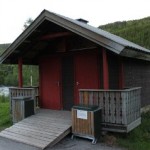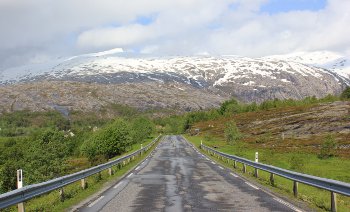Motorhome Travel, Driving & Fuel Prices In Norway (+ Ferries To Norway)
Getting To Norway – Ferries
There are no longer any direct ferries from the UK to Norway. There are three possible options for travelling from the UK to Norway with your own motorhome:
- UK-France by ferry or tunnel from Kent
- Newcastle/Hull/Harwich – Holland by ferry
- Harwich – Esbjerg (DK) by ferry
In all cases, having arrived on the continent, you will have to drive to northern Denmark and catch a further ferry to Norway (we sailed Hirtshals-Larvik) or you will have a long drive round to Norway via Copenhagen and Sweden.
We travelled Hull-Rotterdam and then drove through the Netherlands, Germany and Denmark to Hirtshals (650 miles) where we caught a ferry to Larvik, which is just south of Oslo. The whole journey, from leaving Hull to arriving in Larvik, took just under 48 hours.
Click here to compare ferry prices on different routes.
Motorhome Travel In Norway

Motorhome service point availability: Generally very good, but a little variable in the south west. Motorhome service points are almost always signposted and are often at filling stations. Many are free, sometimes there is a modest charge. Tokens, where needed, can be purchased from the fuel station providing the facility.
Campsites sometimes signpost service points but presumably charge for the use of these for non-guests. Not all service points have all services – sometimes only water and waste or water and toilet dump are available. Earth closets in rural areas provide an additional toilet dump facility, as long as you do not use chemicals in your toilet cassette (although perhaps organic chemicals are ok?).
Many of the service points appear to have been designed to facilitate winter use, at least for water, which often comes from a tap within an insulated cupboard, raised above ground level.
Wild camping availability: Generally very good. Norway is very motorhome friendly and there are lots of Norwegian motorhomers. We didn’t need to use a campsite once in 28 days and always obeyed the (rare) no overnight parking signs.
 Driving In Norway
Driving In Norway
Speed Limits: Norwegian speed limits are low – the standard speed limit for a single carriageway main road is 80km/h (50mph) and higher limits are rare. For the most apart, speed limits are respected by local drivers.
Speed cameras are common in more populated areas. Manned mobile speed traps are rare but do exist and are quite carefully hidden – much more so than in the UK.
Roads: Norway’s roads are pretty good on the whole, although they do show some signs of the severe and prolonged winters. However, compared to the crumbling state of the UK’s roads after just a few weeks of snow and ice, Norwegian roads are impressive, given that they endure months of snow and ice every year.
Norwegian Drivers: Norwegian drivers are much more considerate and patient than those found in continental Europe (and the UK). Tailgating and other forms of aggression are rare and overtaking, when done, is usually controlled and safe. Excessive speeding is rare.
Watch out for long distance lorries on the E6 and other major routes where overtaking is possible – you may wish to enjoy the scenery, but they will wish to make progress and will overtake you where possible, even if it seems a little narrow to you. On the other hand, they tend not to tailgate aggressively as they sometimes do in other countries.
The only drivers who caused us any nervous moments in Norway were foreign motorhome drivers, many of whom do not seem to have discovered that they can use the whole width of the road, right up to the nearside verge… We were lucky to return home with both wing mirrors intact.
Fuel Prices In Norway (plus why diesel didn’t cost me any more than in the UK)
Fuel is expensive in Norway – diesel is more expensive than anywhere else in Europe, I think. Diesel was around £1.50 per litre at the time of our visit, although the improvement in fuel economy that resulted from long distance driving in Norway (at a maximum of 50mph, for many hours on end) meant that on a cost per mile basis, our fuel didn’t cost anymore than it would in the UK.
Our average fuel consumption for the whole trip (including 1,300 miles of 70mph motorway driving through the Netherlands, Germany and Denmark) was 39mpg – about 3mpg better than my usual UK average of 36mpg (low roof Ford Transit panel van). This meant that the cost per mile, for us was virtually identical to the cost of driving in the UK.
Not great, but cheaper than I expected.
Diesel in Norway is normally 1Nkr/litre cheaper than unleaded petrol (95RON and 98RON are usually offered). Prices vary as you travel around, but not particularly predictably. The lowest price we paid for diesel was 12.47Nkr/litre and the most expensive was 13.48Nkr/litre.
Automated (card payment) filling stations are common in rural areas and even manned stations often have automated pumps, so getting fuel 24/7 is not generally a problem. We did not have any problems using our UK debit and credit cards in Norway.
